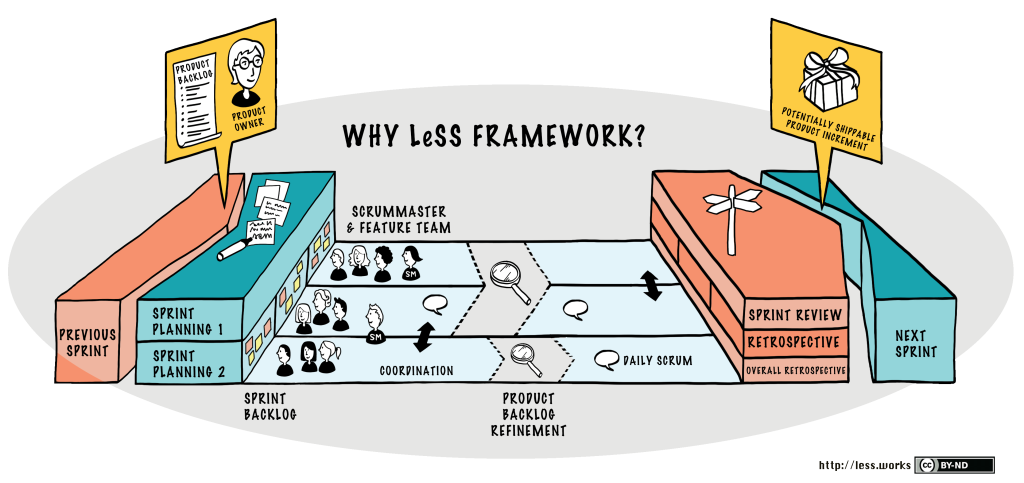Overview Of LeSS (Large Enterprise Scaled scrum framework)
This article gives and overview of LeSS. LeSS is a lightweight Agile framework that helps to scale Scrum to more than one team. It is based on the experience of Bas Vodde and Craig Larman
This article is a part of series Different Agile Scaling Frameworks .

LeSS Framework as defined in Http://Less.works
Scaled Up Version of Single team Scrum
LeSS is a scaled up version of one team scrum. As such, it maintains quite a few of the practices and ideas of a single team doing scrum. Some of the common elements between LeSS and single team scrum are
- A single Product Backlog (because it’s for a product, not a team),
- one Definition of Done for all teams. So that, all the teams to have ONE understanding about what it means to be DONE for the Product
- one Potentially Shippable Product Increment at the end of each Sprint,
- one Product Owner,
- many complete, cross-functional teams (with no single-specialist teams),
- one Sprint.
In LeSS all Teams are in a common Sprint to deliver a common shippable product, every Sprint.
Where LeSS Differs from The Single Team Scrum
Even when the focus is to keep things as similar to the single scrum team as possible in evidently there are changes that the teams have to do in order to deliver a scaled Agile product
Some of the differences are :::
- Sprint Planning Part 1: In addition to the one Product Owner, it includes people from all teams. Let team members self-manage to decide their division of Product Backlog Items. Team members also discuss opportunities to find shared work and cooperate, especially for related items.
- Sprint Planning Part 2: Each team holds the part 2 of Sprint Planning Independently. Though, sometimes for simple coordination and learning two or more Teams may hold it in the same room (in different areas).
- Daily Scrum: This is also held independently by each Team, though a member of Team A may observe Team B’s Daily Scrum, to increase information sharing.
- Coordination: Just Talk, Communicate in Code, Travelers, Open Space, and Communities.
- Overall PBR: There may be an optional and short overall Product Backlog Refinement (PBR) meeting that includes the one Product Owner and people from all teams. The key purpose is to decide which teams are likely to implement which items and therefore select those items for later in-depth single-team PBR. It is also a chance to increase alignment with the Product Owner and all teams.
- Product Backlog Refinement: The only requirement in LeSS is single-team PBR, the same as in one-team Scrum. But a common and useful variation is multi-team PBR, where two or more Teams are in the same room together, to increase learning and coordination.
- Sprint Review: In addition to the one Product Owner, it includes people from all teams, and relevant customers/users and other stakeholders. For the phase of inspecting the product increment and new items, consider a “bazaar” or “science fair” style: a large room with multiple areas, each staffed by team members, where the items developed by teams are shown and discussed.
- Overall Retrospective: This is a new meeting not found in one-team Scrum, and its purpose is to explore improving the overall system, rather than focusing on one Team. The maximum duration is 45 minutes per week of Sprint. It includes the Product Owner, Scrum Masters, and rotating representatives from each Team.
LeSS Variants
LeSS provides two different large-scale Scrum frameworks. Most of the scaling elements of LeSS focus on directing the attention of all of the teams onto the whole product instead of “my part.” Global and “end-to-end” focus are perhaps the dominant problems to solve in scaling. The two frameworks are:
- LeSS: Up to eight teams (of eight people each).
- LeSS Huge: Up to a few thousand people on one product.
LeSS Roles
- Product Owner: one PO for the entire product
- Area Product Owner: one area PO for each requirement
- Scrum Master: one SM for each team
- Development teams: 2 to 8 for each area, no more than 3 areas
LeSS artifacts:
- Product Backlog: a general overview of all the work that needs to be completed
- Area Backlog: a view into the Product Backlog based on the requirement area, where items are split, clarified and prioritized independently
- Sprint Backlog: the list of work that needs to be implemented by the team to complete the selected Area Backlog Items
Advantages of LeSS:
- Scales up Scrum patterns using small batches. SO that business receives benefits every Sprint.
- Structures teams around features
- Supports multiple teams working on one product
- Emphasizes customer collaboration over contract negotiation
- Focuses on collaboration and learning across teams